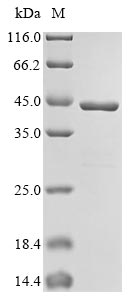Recombinant Streptomyces sp. L-proline cis-3-hydroxylase 1 gets expressed in E. coli and includes the complete protein spanning amino acids 1 to 290. The construct carries an N-terminal 10xHis-tag along with a C-terminal Myc-tag to help with purification and detection steps. SDS-PAGE analysis shows the protein reaches greater than 90% purity, which appears to meet quality standards needed for research work.
L-proline cis-3-hydroxylase 1 catalyzes the hydroxylation of L-proline—a step that seems important in certain metabolic pathways. This enzyme likely plays a role in bacterial secondary metabolism and may be worth studying for its catalytic properties and possible biocatalysis uses. Research on this protein could reveal how enzymes function within Streptomyces species.
Potential Applications
Note: The applications listed below are based on what we know about this protein's biological functions, published research, and experience from experts in the field. However, we haven't fully tested all of these applications ourselves yet. We'd recommend running some preliminary tests first to make sure they work for your specific research goals.
Although the protein is full-length (1-290aa) and the E. coli expression system can produce soluble proteins, the dual tagging system (N-terminal 10xHis and C-terminal Myc) poses significant risks to proper folding and function. Hydroxylases typically require precise coordination of Fe²⁺/α-ketoglutarate cofactors and specific tertiary structure for catalytic activity. The C-terminal Myc tag is particularly concerning as it may disrupt the protein's native conformation or active site accessibility. While the purity >90% indicates minimal contaminants, it doesn't guarantee correct folding of the enzymatically active species. The E. coli system may lack necessary post-translational modifications or chaperones present in the native Streptomyces host. Without enzymatic activity validation, the protein's functional status remains uncertain.
1. Biochemical Characterization of L-proline cis-3-hydroxylase Activity
This recombinant enzyme can be used for activity assays only if hydroxylase activity is experimentally verified. The dual tags may alter the active site conformation or block substrate access, leading to inaccurate measurements of kinetic parameters. The C-terminal Myc tag is particularly problematic as it may interfere with cofactor binding or protein dimerization. Before biochemical studies, validate activity using L-proline and required cofactors (Fe²⁺, α-ketoglutarate, O₂) and measure hydroxyproline production. Consider tag removal for reliable kinetic studies.
2. Substrate Specificity and Inhibitor Screening Studies
The protein may be used for substrate specificity screening only if baseline enzymatic activity is confirmed. The His-tag enables immobilization but may cause steric hindrance that affects substrate access to the active site. For inhibitor screening, false positives/negatives may occur if the tags alter the protein's conformational dynamics. Always include a tag-free positive control and validate hits with alternative assay formats. The high purity supports screening but doesn't ensure functional integrity.
3. Antibody Development and Immunoassay Applications
This recombinant protein can generate antibodies, but the dual tags will likely dominate the immune response, resulting in antibodies that primarily recognize tags rather than enzyme-specific epitopes. If the protein is misfolded, antibodies may not recognize the native enzyme in Streptomyces. For specific antibodies, validate using tag-free protein or confirm recognition of endogenous enzyme. The Myc tag provides a detection control but doesn't guarantee utility for studying native hydroxylase.
4. Protein-Protein Interaction Studies
The tagged enzyme is unsuitable for meaningful interaction studies without tag removal and folding validation. The dual tags may cause non-specific binding or tag-mediated interactions that don't reflect biological partnerships. The E. coli expression system lacks Streptomyces-specific post-translational modifications that might be important for native interactions. For valid results, use tag-free protein and validate interactions with complementary methods.
Final Recommendation & Action Plan
To ensure reliable results, first validate the enzymatic activity of the recombinant hydroxylase using established assays (e.g., HPLC or mass spectrometry to detect hydroxyproline formation from L-proline). Given the significant interference risk from dual tags, remove both tags via proteolytic cleavage (if cleavage sites are present) and re-purify the protein for functional studies. For antibody development, use the current protein but characterize resulting antibodies against tag-free hydroxylase and endogenous enzyme from Streptomyces. For interaction studies, avoid using the dual-tagged version altogether unless the tags are removed and proper folding is confirmed. Always include appropriate controls such as tag-free proteins, activity-negative mutants, and Streptomyces wild-type extracts in experiments. The E. coli expression system provides cost-effective production but may not replicate the native enzymatic properties without careful validation.






